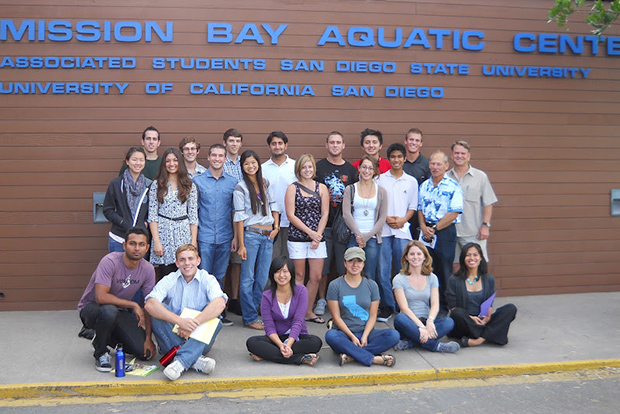
UC San Diego and SDSU Collaborate to Platinum LEED Certify the Mission Bay Aquatic Center
By:
- Christine Clark
- Natalia Goloborodko
Published Date
By:
- Christine Clark
- Natalia Goloborodko
Share This:
Article Content

UC San Diego and San Diego State students in front of the Mission Bay Aquatic Center (MBAC), the world’s largest instructional waterfront facility.
Students at the University of California, San Diego and San Diego State University are collaborating to improve the energy efficiency and reduce the carbon footprint of the Mission Bay Aquatic Center (MBAC) in an effort to help the center earn a platinum Leadership Energy and Environmental Design (LEED) certification.
“Young people can make a big difference in this world, and this group’s work proves that,” said Cory Trusty, president of U.S. Green Building Council (USGBC) Students at UC San Diego, a student group that helps raise environmental awareness and develop sustainable practices.
For the project, UC San Diego students worked with SDSU students to “self-certify” the aquatic center through measuring and documenting the ways in which the MBAC building, the world’s largest instructional waterfront facility, already met LEED platinum certification requirements. Under the supervision of Michelle Perez, head of UC San Diego’s LEED team and UC San Diego sustainability analyst, students gathered data by running energy and water audits, modeling the building’s airflow, interviewing staff members and surveying occupants. They also wrote new goals within the MBAC policies to ensure the center continues to operate sustainably.
“I’m truly amazed when I see our members come together and work toward the common goal of improving the way we use resources,” said Trusty. “As students we really do want to make positive change in the world.”
MBAC is on track to receive a platinum certification and its application to USGBC has been submitted, according to Perez.
“Fortunately, little retrofitting and change to the equipment was necessary,” said Perez. “The structure had already received a 100 percent energy rating, meaning that it rates in the highest percentile of similar buildings.”
The new goals and policies that have been adopted at the center involve “green” cleaning, sustainable purchasing and waste diversion.
Since the LEED certification process can cost thousands of dollars, UC San Diego students worked with SDSU students to avoid these fees through their knowledge, leadership and experience.
“One of the selling factors of this endeavor was that UC San Diego’s USGBC student group would teach SDSU’s student group, which is just getting started, how to help LEED certify a building,” said Trusty.
Perez has guided the USGBC student group at UC San Diego in more than five LEED certifications on campus. Having completed these projects, the team had acquired the knowledge and experience necessary to teach SDSU’s USGBC students how to self-certify their buildings, according to Perez.
Students from UC San Diego’s USGBC were recently successful in helping the San Diego Super Computer Center earn a LEED gold rating. There are a total of 13 LEED certified buildings on UC San Diego’s campus. Earlier this year, the Revelle College Charles David Keeling apartments were LEED platinum certified––a first for any structure on campus, and for any residential housing building in the entire University of California system.
Created by the USGBC, the LEED rating is the nationally accepted benchmark for the design, construction and operation of high-performance green buildings.
For more information on the Mission Bay Aquatic Center, go to mbaquaticcenter.com. For more information on UC San Diego’s sustainability efforts, please visit sustainability.ucsd.edu.
Share This:
You May Also Like
Stay in the Know
Keep up with all the latest from UC San Diego. Subscribe to the newsletter today.


